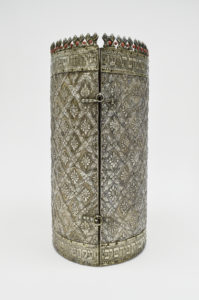Tik (Torah case)
Tik (Torah Case)
Iraq, 1916
Chased silver on wood, h. 22 x dia. 10 ½ in.
Inscription: The owners of the Sefer Torah may take it to other places or give permission to remove the sefer Torah and place it where they so desire (translation).
Cincinnati Skirball Museum, formerly S. Kirschstein collection, 57.3
Great reverence is given to the Torah, or Five Books of Moses composed of Genesis, Exodus, Levitivus, Numbers, and Deuteronomy The Torah contains ritual and moral laws that guide the lives of Jews everywhere.
The Torah occupies the most honored place in Jewish liturgy and is the central element of the worship serviced. The scroll is handwritten on parchment by a scribe who receives extensive training and is bound by a set of strict rules. There is no punctuation, decoration, or illumination, and its calligraphy has remained unchanged for centuries. The pieces of parchment are sewn together and attached to two wooden rollers. The Torah is taken from the ark, the place of honor, and read during services on the Sabbath (Saturday), Monday, Thursday, and major festivals. The entire Torah is read over the course of one calendar year, according to set weekly portions.
Torah ornaments are created as a fulfillment of God’s commandment in the book of Exodus to beautify ritual objects: “This is my God, and I will glorify Him.” (15:2). The tik, or Torah case, is an object of artistic ornamentation designed to emphasize respect for the Torah. In addition, the tik protects the Torah scroll and serves as a portable ark. Originating in Iraq during the tenth century, it is associated with Sephardic communities, namely those Jewish communities in North Africa, Turkey, Spain and the Middle East.
This elegant cylindrical tik is made of wood with an overlay of silver chased in a rhythmic floral pattern. Within its crownlike rim is a setting of forty-eight beads. The Hebrew inscription that gives the owner permission to move the precious Torah to another location was commonly used to prevent a ritual object from becoming communal property after its donation to a synagogue.
Publications:
Artistic Expressions of Faith in Judaism, Christianity, and Islam, ed. Abby S. Schwartz, 1997, p. 3.

